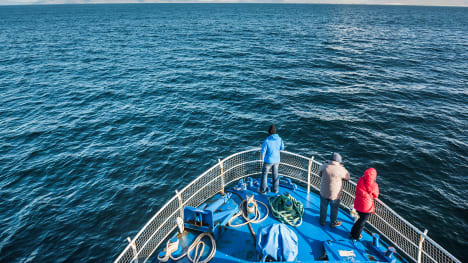() — After a four-year hiatus, Iceland’s last remaining whaling company, Hvalur hf., will resume its hunt this summer, much to the chagrin of tourism officials.
With the Covid-19 pandemic having a devastating impact on Iceland’s tourism sector, the last thing many officials want is a backlash over whaling.
“It is actually well known and widely reported that the tourism industry believes that whaling damages Iceland’s image as a tourist destination,” said Jóhannes Þór Skúlason, executive director of the Iceland Tourist Office. “All you need to do is see how whaling is reported in the foreign press.”
“It is often reported in larger publications with heated coverage,” Jóhannes continued. “In the tourism industry, both in private companies and in public surveys; In letters, phone calls, and other communications, whaling has a very precise effect, and tourism companies feel it as whaling comes back into the discussion.”
Company representatives have expressed outrage at the planned whaling. “The tourism industry and the majority of Icelandic citizens are against whaling,” said Ásberg Jónsson, CEO of TravelConnecta large Reykjavík-based travel services company.
“It is sad and frustrating to hear that this company, Hvalur, intends to resume the slaughter of these animals in Iceland. It is very damaging to the reputation of our country. This, in turn, has repercussions for our export and tourism industries. “.
The stakes are high as tourism in Iceland came to a halt during the height of the covid-19 pandemic. “We are an island, so obviously the barrier to travel here is a bit higher than for people visiting a neighboring country,” said Sigríður Dögg Guðmundsdóttir, director of VisitIceland.
tourism dependency
Whale watching is a popular tourist activity in Iceland. (Matthew Williams-Ellis/VWPCS/AP)
While Covid-19 wreaked havoc on nations around the world, many countries are not as reliant on tourism as Iceland. Before the pandemic, tourism was the country’s main export.
According to data from the Icelandic Chamber of Commerce, the growth of the sector peaked in 2017 when tourism exports accounted for 42% of the country’s total exports.
In the wake of the pandemic, GDP growth took a hit last year. Activities related to travel reservations, air transport, accommodation and restaurants decreased between 50% and 75% from 2019. This caused a contraction of the tourism sector of 3.9% of GDP in 2020.
Hvalur last sent its boats out to hunt in the summer of 2018, and a total of 146 whales were caught during the season. Depending on the light, the whaling season usually starts in June and lasts until September. Around 150 people are estimated to work on the whaling ships at the whaling station in western Iceland and at the company’s processing facilities outside of Reykjavík.

The tails of two 35-tonne fin whales killed by hunters in June 2009. (Halldor Kolbeins/AFP/Getty)
Some argue that whaling is part of Icelandic culture and should be resumed.
“Whaling has a long tradition here in Iceland, and I think reasonable and controlled whaling should be allowed,” a casual worker at the whaling station, who did not want to be identified because it could affect his employment, told Travel. “Only about 125-150 fin whales are taken each year in the seven seasons since Iceland started whaling again in 2006. That year, I think only eight whales were taken.”
negative emails

Tourism workers say whaling damages Iceland’s reputation. (Mayall/Ullstein Bild/Getty Images)
It is puzzling to many that Hvalur, which is led by CEO Kristján Loftsson, continues to hunt whales in light of environmental concerns and poor finances.
“It’s hard for us to understand why, as whaling is not only a harmful practice, but it’s no longer financially viable,” Travel Connect’s Ásberg said.
Hvalur’s Loftsson declined to comment.
Iceland’s whaling activities account for about 3% of all whales hunted worldwide, according to a 2019 report from the Icelandic Ministry of Industries and Innovation. In 2017, the total income of whale watching companies amounted to 3.2 billion Icelandic kroner (US$26.5 million). Meanwhile, Hvalur’s income from whaling activities in 2017 amounted to 1.7 billion kronor (US$14.1 million).
However, whale watching tours generate more revenue as it is a popular activity for tourists throughout the year.
Many are fed up with the impact of one company, especially as tourism companies hope to return to “pre-Covid” numbers of tourists this summer, and a controversial topic like whaling is disappointing.
“Overall, our travel brands haven’t experienced many cancellations because of this, but we do get negative emails about it from time to time,” Ásberg said. “We always explain that as a company we do not support whaling at all. Everyone should be able to see these amazing creatures thrive in their natural habitat.”
One last hurrah?

Tourism in Iceland was affected by covid. (Ryan Pyle/Getty Images)
The 2022 season could be Hvalur’s last, as the current license to hunt whales will expire in 2023, and the Icelandic Ministry of Fisheries and Agriculture will decide whether or not to stop issuing whaling licenses from 2024. It seems that there is little demand for whale products and that the industry does very little for the Icelandic economy.
“Any whaling in Icelandic waters is based on science and in accordance with international law,” Sigríður said. “Hvalur has the required license to undertake whaling this summer. It is up to the management and owners to determine whether they will use it and it is up to the Icelandic people and government to determine whether licenses will be granted in the future. In the last three years, only caught a minke whale and no large whales.
All covid-19 restrictions they went up in March 2022 and tourism executives have high hopes for a good summer.
“Tourism in Iceland is recovering well,” said Sigríður. “In our projections, we expect near normal numbers this summer and a full return next year.”












Add Comment